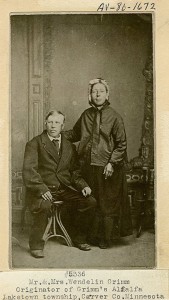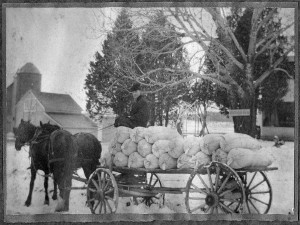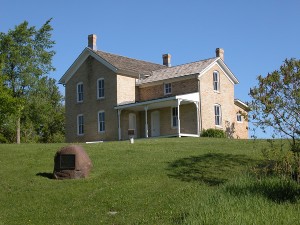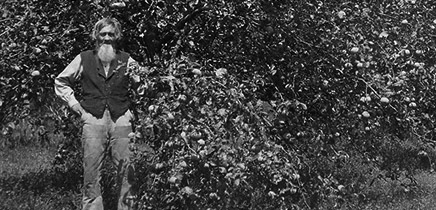Wendelin Grimm was born October 18, 1818 in Kulsheim, Baden, Germany, to Valentine and Marie (Adelmann) Grimm. He grew up in a farm rich area of southern Germany, learning important crops and farming practices. In 1845, Grimm married Julianna Segner (born June 15, 1821) of Steinback, Baden, Germany. The Grimms chances to own a farm were limited by the land inheritance practices of the time. Farming and crop prices were under pressure, and their future in Germany looked grim. With a growing family to support, sons Frank and Joseph and daughter Ottilia, Wendelin and Julianna looked to America for their family’s future.
After landing in New York, the Grimm family chose to continue westward in search of good farmland. They reached the Chaska on September 1, 1857. In 1859, a fourth child, Caroline was born. The same year, Grimm purchased 160 acres of land in Laketown Township (near Victoria) from John Neunsinger.
In 1872, Grimm purchased a second farm between Victoria and Chaska. When his oldest son Frank married Rosalia (Rosella) Pograbo, they took over the original farm, while the rest of the Grimms moved to the new one. On June 1, 1875, Joseph married Mary Agnes Browers, and moved to Texas, back to Chaska, then to Tampa, Florida. Ottilia married Hubert Kelzer in 1889, and lived with her parents on the new farm, which has been passed down through the Kelzer family. Youngest daughter Caroline and husband William Glatzel settled a mile north of Chaska. Wendelin Grimm died December 8, 1890, followed by Julianna on October 28, 1897. Both are buried in the St. Victoria Cemetery, in Victoria, MN.
Wendelin Grimm’ farming brought him fame. When the Grimms came to America, they packed a fifteen-pound bag of “Lucern” or “Ewiger Klee” (everlasting clover). Grimm began planting this feed crop over the winter months, saving the seeds that survived the cold temperatures, and replanting them the following year. Over the next fifteen years, more seeds survived, though the winter of 1874-1875 was so harsh it nearly caused his whole crop to die out. Grimm alfalfa became winter hardy, grown year round to keep cattle and dairy cows well fed.
At first, Grimm only sold this crop to his neighbors, as they noticed how well fed his cows were. Elsewhere in Minnesota, farmers let animals graze on vacant land or open range. The Enclosure Act of 1871 changed this. Fences were built, and feed crops needed. By 1889, Carver County was producing nearly fifty percent of all alfalfa in the state. In the 1890s, the growth of the dairy industry in the “Golden Buckle of the Dairy Belt” led to even more alfalfa being grown. Farmers wanted the hardier Grimm alfalfa for its high yields, high protein content, ability to return nutrients to the soil, ability to crowd out weeds, and hardiness in cold climates.
Over time, local farmers like A.B. Lyman, researchers like Charles Brand, and University of Minnesota Agricultural Extension Station head Professor Willet Hays (later U.S. Assistant Secretary of Agriculture) brought national attention to Grimm alfalfa. Tests comparing it to other strains proved its better quality. A.B. Lyman grew so much of it, his farm became known as “Alfalfadale”. In 1916, the Grimm Alfalfa Growers Association began in North Dakota. By the 1930s, Grimm Alfalfa was the preferred variety in the United States. In the twenty-first century, Grimm Alfalfa is the source of all modern varieties of alfalfa grown on more than twenty-five million acres of farmland in the United States. It is valued at ten billion dollars annually.
In 1924, the Grimm Alfalfa Growers’ Association honored Wendelin Grimm’s achievement with a plaque on his original farm. In the 1950s, the farm became part of a conservation land reserve. In 1963, this land became the Carver Park Reserve. In 1974, the Grimm house and farm were designated on the National Register of Historic Places. In the twenty-first century, there are tours, living history, and agricultural practice demonstrations on the site.
Turning Point: In 1859, Wendelin Grimm begins planting alfalfa fields, creating a winter hardy strain and becoming a pioneer in American agricultural history.
Chronology:
- October 18, 1818: Wendelin Grimm born to Valentine and Marie (Adelmann) Grimm in Kulsheim, Baden, Germany
- June 15, 1821: Julianna Segner born in Steinback, Baden, Germany
- 1845: Wendelin and Julianna (Segner) Grimm marry
- 1857: Grimm family immigrates to America, arriving in Chaska in September
- 1859: Their fourth child Caroline is born
- 1859: The Grimms purchase 160 acres of farmland in Laketown Township from John Neunsinger
- 1859: Grimm begins fifteen years of planting alfalfa seeds
- 1871: Enclosure Act put into effect
- 1872: A second farm is purchased between Victoria and Chaska
- 1874?: Frank marries Rosalia Pograbo and they take over the original farmstead
- June 1, 1875: Joseph marries Mary Agnes Browers, and moves to Texas, back to Chaska, then to Tampa, Florida.
- 1874-1875: Harsh winter nearly causes Grimm Alfalfa to go extinct
- 1876: Chaska brick Grimm farmhouse is built
- 1889: Ottilia Grimm marries Hubert Kelzer and they live with her parents on the second farmstead
- 1889: Carver County is producing nearly fifty percent of all alfalfa in the state of Minnesota
- December 8, 1890: Wendelin Grimm dies
- October 28, 1897: Julianna Grimm dies
- 1890 to 1900: Farmers in Carver County turn more to the dairy industry and supporting feed crops like Grimm alfalfa, becoming the “Golden Buckle of the Dairy Belt”.
- 1903: Grimm Alfalfa is officially acknowledged by the U.S. Department of Agriculture
- 1916: Grimm Alfalfa Growers Association is formed in North Dakota
- 1924: A plaque honoring Wendelin Grimm’s achievements is dedicated on the original farmstead
- 1930’s: Grimm Alfalfa is the preferred variety in the United States
- 1963: The original farmstead becomes part of Carver Park Reserve
- 1974: The original farmstead placed on the National Register of Historic Places
- 2008: Grimm Alfalfa is recognized by the Minnesota Historical Society as one of the 150 most influential things in Minnesota History.
- 2012: Grimm Alfalfa is the source of all modern varieties of alfalfa grown on more than twenty-five million acres in the United States and valued at ten billion dollars annually.
BIBLIOGRAPHY
Diethelm, John A. Compiled by Vince Winninghoff. The Victoria Story. Victoria, MN: 1957.
Edwards, Everett E. and Horace H. Russell. “Wendelin Grimm and Alfalfa”. Minnesota History Quarterly, March 1938, Vol. 19 Issue 1: 21-33. http://collections.mnhs.org/mnhistorymagazine/articles/19/v19i01p021- 033.pdf
Edwins, Steven, Principal Investigator. “The Wendelin and Julianna Grimm Farmstead: a Reuse Study”.
Project manual, joint project of the Minnesota Historical Society and Surburban Hennepin Park District, Carver Park Reserve, August 1994.
Kelzer, Frank. “The History of Grimm Alfalfa”. Chaska, MN: September 1, 1957.
RELATED RESOURCES
Secondary:
Balmer, Frank E. “The Farmer and Minnesota History”. Minnesota History Magazine, September 1936, Vol. 7 Issue 3: 199-217. http://collections.mnhs.org/MNHistoryMagazine/articles/7/v07i03p199-217.pdf
Brand, Charles J. “Ancestral Home of Grimm Alfalfa”. Fertiizer Review, September-October 1954, Vol. 9 Issue 4: 8-10.
Edwins, Steven, AIA. “The Wendelin Grimm Farm House Stabilization”. Project manual, Carver Park Reserve, 1994.
Holcombe, Maj. R.I., editor. Compendium of History and Biography of Carver and Hennepin Counties, Minnesota. Henry Taylor and Company: Chicago, 1915.
Lofstrom, Ted and Lynne VanBrocklin Spaeth. Carver County: A Guide to Its Historic and Prehistoric Places. St. Paul: Minnesota Historical Society Press, 1978.
“The Annual Meeting”. Minnesota History Magazine, March 1938, Vol. 19 Issue 1: 63-70. http://collections.mnhs.org/MNHistoryMagazine/articles/19/v19i01p063-070.pdf
Tremblay, Ruth and Lois Schulstad. Images of America: Carver County. Arcadia Publishing: Charleston, South Carolina, 2011.
Warner, George E. and Charles M. Foote. History of the Minnesota Valley: Carver County. Minneapolis: North Star Publishing Company, 1882. Republished 1986.



“This article used with the permission of MNopedia, operated by the Minnesota Historical Society, under a Creative Commons License. No changes have been made to the article’s content.”


